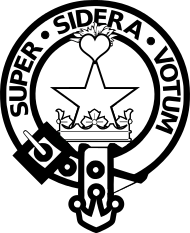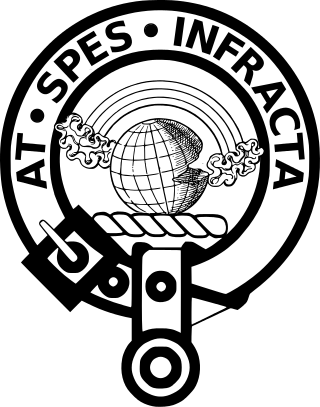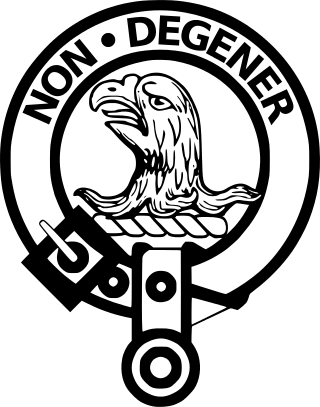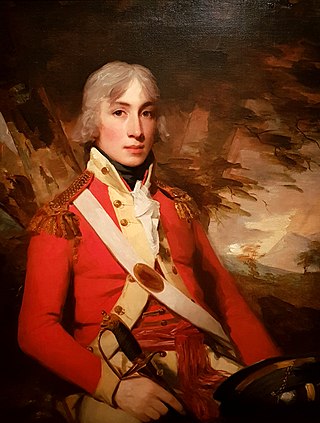| Clan Rattray | |||
|---|---|---|---|
 | |||
| Motto | Super sidera votum (My wishes are above the stars) [1] | ||
| Chief | |||
 | |||
| Lachlan Rattray [1] | |||
| of Rattray [1] | |||
| Seat | Craighall | ||
| Historic seat | Rattray Castle | ||
| |||
| |||
Clan Rattray is a Highland Scottish clan. [2]
| Clan Rattray | |||
|---|---|---|---|
 | |||
| Motto | Super sidera votum (My wishes are above the stars) [1] | ||
| Chief | |||
 | |||
| Lachlan Rattray [1] | |||
| of Rattray [1] | |||
| Seat | Craighall | ||
| Historic seat | Rattray Castle | ||
| |||
| |||
Clan Rattray is a Highland Scottish clan. [2]
The name Rattray is taken from the barony of Rattray in Perthshire. [2] This barony has been in their possession since the eleventh century. [2] The Rattray estate includes the ruins of a pict rath-tref or fort dwelling. [2] It stands on a sandy mound which is associated by local tradition with Pagan rites. [2]
The first recorded Laird of Rattray was Alan who witnessed charters by William the Lion and Alexander II of Scotland. [2]
During the Wars of Scottish Independence, Alan's grandson, Eustace Rattray, was captured at the Battle of Dunbar (1296) and taken to England as a prisoner. [2] Eustace's son was Adam Rattray who swore fealty to Edward I of England, appearing on the Ragman Rolls of 1296. [2] Adam was succeeded by his son, Alexander Rattray, who was amongst the barons who sat in the Parliament at Ayr to determine the succession to the throne in 1315. [2] Alexander was succeeded by his brother, Eustace, the sixth Laird of Rattray, who was accused of being involved in a plot to depose Robert the Bruce, but he was latter acquitted. [2]
In 1463 Sir Silvester Rattray of Rattray was an ambassador to England and inherited from his mother large estates around Fortingall in Atholl. [2] This caused the powerful Stewart Earl of Atholl to be jealous. [2] Silvester Rattray was succeeded by his son, John, who had been knighted in 1488 by James IV of Scotland. [2] His eldest son died serving in the Netherlands as a professional soldier but he left another two sons and two daughters. [2] The eldest of the two daughters was Grizel who had married John Stewart, Earl of Atholl and the earl promptly claimed half of the barony of Rattray in her right. [2] The earl also induced his wife's sister, Elizabeth, to try and obtain her share of the Rattray barony. [2] Sir John Rattray's second son, Patrick Rattray, was driven from Rattray Castle in 1516 by the Earl of Atholl and was forced to take refuge in Nether Kinballoch where he built a new house at Craighall. [2] However the Stewart Earl of Atholl murdered him in 1533. [2]
The third son of Sir John Rattray was another Silvester Rattray who succeeded his murdered brother. [2] Due to the Earl of Atholl's continuing threats he petitioned to the king for dispensation to be legally recognised in the courts in Dundee instead of Perth where the Earl of Atholl had great influence and Silvester considered the visit too dangerous. [2]
Silvester Rattray was succeeded by his son, David Rattray of Craighall, who had three sons. [2] The second son was another Silvester Rattray who was Reverend of Persie and became the first minister of Rattray after the Scottish Reformation. [2] The eldest son, George, was murdered in 1592 and so Silvester, the younger son, succeeded to the title. [2]
Silvester Rattray was tutored by his uncle, the Reverend John Rattray and allied himself to the powerful Earls of Erroll, chiefs of Clan Hay. [2] He died in 1612 leaving three sons. [2] The eldest son was David Rattray who fought for Charles I of England during the Scottish Civil War and as a result his seat at Craighall endured a short siege. [2] The youngest son was John Rattray who was captured at the Battle of Worcester in 1651 after the defeat of Charles II of England and Rattray was imprisoned in the Tower of London. [2]
The Rattrays sought to consolidate their lands and in 1648 Patrick Rattray obtained a new charter to their lands under the great seal which united the barony of Kinballoch with Rattray and their other associated parishes into the one free barony of Craighall-Rattray. [2] In 1682 the new barony passed to Patrick's eldest son and also laid claim to the Rattray lands that had been sized by the Stewart Earl of Atholl in the 16th century. [2]
James Rattray of Rannagulzion and Corb fought at the Battle of Killiecrankie in 1689. Referred to as James, son of David Rattray of Rannagullane. [3]
Patrick Rattray's only son, Thomas Rattray, entered the Church and rose to be the Bishop of Brechin (then of Dunkeld) and became Primus of Scotland in 1739. [2] Thomas was a Jacobite and his second son, John Rattray, was the physician to the Jacobite leader, Charles Edward Stuart, following him throughout the Jacobite rising of 1745. [2] He was captured after the Battle of Culloden but upon the intervention of Duncan Forbes, Lord Culloden he was reprieved. [2] The bishop's eldest son, James Rattray, sheltered Jacobite fugitives at Craighall. [2]
James Rattray of Rannagulzion was commissioned as a major of foot in the Atholl brigade in the 1745 rising. [4] See commission into Prince Charles's army as a Major of foot in Tullibardines regiment National Library of Scotland. Served in the Ogilvie regiment. [4]
Col. Thomas Rattray, C.S.I., C.B., B.S.C. (a Rattray of Rannagulzion) commanded the Governor-General's bodyguard cavalry and is well known for having raised a new police battalion, known as the Bengal Military Police Battalion, at Lahore on 15 April 1856, [5] [6] which distinguished itself throughout the Indian Mutiny. This famous battalion, which was regularised as an infantry unit in the British Indian Army as the 45th Rattray's Sikhs in the 1860s, later became the 3rd Battalion 11th Sikh Regiment in 1922 and then the 3rd battalion the Sikh Regiment (Rattray's) in the modern Indian army. [7]
The twenty-second and twenty-third Lairds of Rattray died without heirs and the estate then passed to a cousin, the Honourable James Clerk Rattray, sheriff depute of Edinburgh. [2] James Clerk Rattray, the twenty-sixth Laird was a distinguished soldier who rose to the rank of general and who in 1897 was created a Knight of the Bath. [2] He served during the Crimean War and during the Indian Mutiny of 1857. [2]
The Chief of Clan Rattray is Lachlan Rattray of Rattray who is the 29th Chief of Clan Rattray. Lachlan Rattray of Rattray is a current member of the Standing Council of Scottish Chiefs. [8]
The seat of the chief of Clan Rattray is still at Craighall-Rattray. [2] Their historic seat was at Rattray Castle. [2]
The septs of the Clan Rattray include: Rannagulzion, Dalrulzion, Brewlands, Persie and Beatts.
Variations in spelling include Ratray, Ratre, Ratteray, Ratteree, Ratterree, Rattray, Retrey, Rettra, Rettray, and Rotray.

Duke of Atholl, named after Atholl in Scotland, is a title in the Peerage of Scotland held by the head of Clan Murray. It was created by Queen Anne in 1703 for John Murray, 2nd Marquess of Atholl, with a special remainder to the heir male of his father, the 1st Marquess.

Clan Robertson, is correctly known as Clan Donnachaidh is a Scottish clan. The principal surnames of the clan are Robertson, Reid and Duncan but there are also many other septs.

Earl of Dalhousie, in the County of Midlothian, is a title in the Peerage of Scotland, held by the Chief of Clan Ramsay.

Lord Lovat is a title of the rank Lord of Parliament in the Peerage of Scotland. It was created in 1458 for Hugh Fraser by summoning him to the Scottish Parliament as Lord Fraser of Lovat, although the holder is referred to simply as Lord Lovat. It was a separate title from the Scottish feudal lordship of Lovat, already held by the highland Frasers. In 1837 they were created a third title, Baron Lovat, of Lovat in the County of Inverness, in the Peerage of the United Kingdom. The holder is separately and independently the Chief of the highland Clan Fraser of Lovat.

Clan Arbuthnott is a Lowland Scottish clan.

Clan Scott is a Scottish clan and is recognised as such by the Lord Lyon King of Arms. Historically the clan was based in the Scottish Borders.

Clan Murray is a Highland Scottish clan. The chief of the Clan Murray holds the title of Duke of Atholl. Their ancestors were the Morays of Bothwell who established the family in Scotland in the 12th century. In the 16th century, descendants of the Morays of Bothwell, the Murrays of Tullibardine, secured the chiefship of the clan and were created Earls of Tullibardine in 1606. The first Earl of Tullibardine married the heiress to the Stewart earldom of Atholl and Atholl therefore became a Murray earldom in 1626. The Murray Earl of Atholl was created Marquess of Atholl in 1676 and in 1703 it became a dukedom. The marquess of Tullibardine title has continued as a subsidiary title, being bestowed on elder sons of the chief until they succeed him as Duke of Atholl.

Clan Menzies ; Scottish Gaelic: Clann Mèinnear; a member is a Mèinnearach) is a Highland Scottish clan.

Clan MacLaren is a Highland Scottish clan. Traditional clan lands include the old parish of Balquhidder which includes the villages of Lochearnhead and Strathyre, and is about 18 miles (29 km) long and 7 miles (11 km) broad, spanning 54,675 acres (22,126 ha), long known as "Maclaren Country".

Clan Maclachlan, also known as Clan Lachlan, Clann Lachainn (Argyll), and Clann Lachlainn, is a Highland Scottish clan that historically centred on the lands of Strathlachlan on Loch Fyne, Argyll on the west coast of Scotland. The clan claims descent from Lachlan Mor, who lived on Loch Fyne in the 13th century, and who has left his name upon the countryside he once controlled: places such as Strathlachlan, Castle Lachlan and Lachlan Bay. Tradition gives Lachlan Mor a descent from an Irish prince of the O'Neill dynasty, Ánrothán Ua Néill, son of Áed, son of Flaithbertach Ua Néill, King of Ailech and Cenél nEógain, died 1036. Clan Maclachlan has been associated with other clans, such as Clan Lamont, Clan Ewen of Otter, Clan MacNeil of Barra, and the MacSweens: as all claim descent from Anrothan O'Neill who left Ireland for Kintyre in the 11th century. From this descent the clan claims a further descent from the legendary Niall Noigíallach, High King of Ireland, who lived from the mid 4th century to the early 5th century.

Clan Moncreiffe is a Highland Scottish clan.

Clan Irvine is a Scottish clan.

Clan Haldane is a Lowland Scottish clan.

Clan Hope is a Scottish clan of the Scottish Lowlands.

Clan Stewart is a Scottish Highland and Lowland clan. The clan is recognised by Court of the Lord Lyon; however, it does not have a Clan Chief recognised by the Lord Lyon King of Arms. Because the clan has no chief it can be considered an armigerous clan; however, the Earls of Galloway are now considered to be the principal branch of this clan, and the crest and motto of The Earls of Galloway's arms are used in the Clan Stewart crest badge. The Court of the Lord Lyon recognises two other Stewart/Stuart clans, Clan Stuart of Bute and Clan Stewart of Appin. Clan Stuart of Bute is the only one of the three clans at present which has a recognised chief.

Clan Wedderburn is a Lowland Scottish clan.

Clan Wemyss is a Lowland Scottish clan.

Clan Crawford is a Scottish clan of the Scottish Lowlands. The clan is of Scandinavian and Anglo-Saxon origin. There was in the early 18th century a mistaken belief that the clan had Norman origins. While historically recognised as a clan by the Court of the Lord Lyon, it is now an armigerous clan as it no longer has a chief. The last chief was Hugh Ronald George Craufurd, who sold his land and moved to Canada in 1904. He died in Calgary in 1942, leaving no male heirs.
William Murray, 2nd Lord Nairne was a Scottish peer and Jacobite who fought in the Rising of 1715, after which he was attainted and condemned to death for treason, but in 1717 he was indemnified and released.

Major-General Alexander Murray Macgregor, born Alexander Murray, was a Scottish army officer in the British East India Company.
{{cite web}}: Unknown parameter |deadurl= ignored (|url-status= suggested) (help)CS1 maint: archived copy as title (link) The Standing Council of Scottish Chiefs